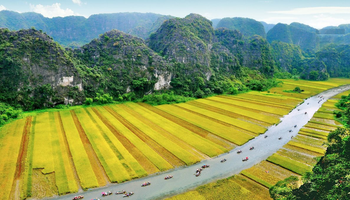Most recently, the smooth piloting of a number of inter-provincial one-day tours departing from Hanoi and Ho Chi Minh City in the form of "closed tours" has shown positive signs for the restart of domestic tourism. Typically, the first group of 17 tourists from Hanoi to Bac Giang (October 23); and two groups of tourists who are doctors, frontline forces in the fight against the pandemic in Ho Chi Minh City, to Ba Den Mountain, Tay Ninh (October 18 and October 21).
In order to deploy the "closed tour", each travel company has carefully prepared all aspects. The service staff and guides are all vaccinated with COVID-19 vaccines, periodically tested, and thoroughly trained in the process of serving guests safely. Tourists participating in "closed tour" programmes are thoroughly surveyed for epidemiological information and travel history, ensuring they get the full dose of vaccine and are tested before departure date. The local side also prioritises the use of complexes, isolated tourist areas, far from residential areas to welcome domestic tourists; having a plan to handle medical incidents if they happen.
But the reopening of tourism in many places is in fact still very conservative, because some localities still have their own standards. Many local tourism associations and travel companies reflect the inconsistency between localities in the implementation of Resolution 128. The most difficult thing is the lack of consensus on common safety criteria among localities. Currently, each locality is still coming up with its own safety plans for welcoming tourists as well as conditions for businesses providing tourism services. This greatly affects the overall recovery of tourism.
The two factors that are considered the most important to reopen tourism are that the locality ensures vaccine coverage for local people (including tourism facility staffs) and has suitable plans and facilities to handle infections arising from tourists.
Travel agencies expect provinces and cities to set up hotlines to provide information for travel companies and tourists so that guests can access information about COVID-19 testing, with specific instructions in the case of an incident in the group of guests whereby a person is suspected of being infected with COVID-19; and medical conditions to handle isolation of one person or the whole group, isolation at accommodation facilities or concentrated isolation.
In order to attract customers, travel businesses, accommodation, transportation and other local service providers must have close cooperation to be able to offer safe and attractive product packages, reasonable prices and flexible terms.
Currently, the lack of information and specific instructions from the localities make travel businesses very confused in building specific inter-provincial tourism products. Local tourism businesses are cautious in considering reopening because the cost of restarting operation is very expensive. If opening the door without guests or few guests, it will be even more difficult.
The time of November 1 - the time when many localities allow to reopen inter-provincial tourism has arrived, but tourism businesses must still wait for unified instructions between localities.
In recent days, a number of localities have appeared new outbreaks in the community due to people coming back from provinces that used to be the southern epidemic hot spots, making these localities more vigilant. Complicated epidemic developments may cause these localities to return to rigid anti-epidemic measures or impose other restrictive regulations, making it difficult to reopen for tourism.
In order for the reopening of domestic tourism is no longer reserved, localities need to accelerate the speed of vaccination to achieve the necessary coverage. At the same time, it is necessary to soon have proactive, timely and consistent guidelines and regulations among localities in controlling travel, with plans for handling medical incidents in tourism operation, in order to help the stages of transportation, accommodation, restaurant services, shopping, and places to visit operate synchronously.
















